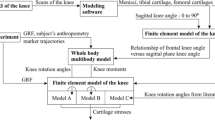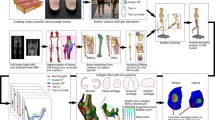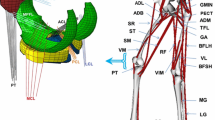Abstract
The study objective was to construct and validate a subject-specific knee model that can simulate full six degree of freedom tibiofemoral and patellofemoral joint behavior in the context of full body movement. Segmented MR images were used to reconstruct the geometry of 14 ligament bundles and articular cartilage surfaces. The knee was incorporated into a lower extremity musculoskeletal model, which was then used to simulate laxity tests, passive knee flexion, active knee flexion, and human walking. Simulated passive and active knee kinematics were shown to be consistent with subject-specific measures obtained via dynamic MRI. Anterior tibial translation and internal tibial rotation exhibited the greatest variability when uncertainties in ligament properties were considered. When used to simulate walking, the model predicted knee kinematic patterns that differed substantially from passive joint behavior. Predictions of mean knee cartilage contact pressures during normal gait reached 6.2 and 2.8 MPa on the medial tibial plateau and patellar facets, respectively. Thus, the dynamic modeling framework can be used to simulate the interaction of soft tissue loads and cartilage contact during locomotion activities, and therefore provides a basis to simulate the effects of soft tissue injury and surgical treatment on functional knee mechanics.








Similar content being viewed by others
References
Amiri, S., and D. R. Wilson. A computational modeling approach for investigating soft tissue balancing in bicruciate retaining knee arthroplasty. Comput. Math. Methods Med. 2012:652865, 2012.
Anderson, C. J., B. D. Westerhaus, S. D. Pietrini, C. G. Ziegler, C. A. Wijdicks, S. Johansen, L. Engebretsen, and R. F. LaPrade. Kinematic impact of anteromedial and posterolateral bundle graft fixation angles on double-bundle anterior cruciate ligament reconstructions. Am. J. Sports Med. 38:1575–1583, 2010.
Anderst, W., R. Zauel, J. Bishop, E. Demps, and S. Tashman. Validation of three-dimensional model-based tibio-femoral tracking during running. Med. Eng. Phys. 31:10–16, 2009.
Arnold, E. M., S. R. Ward, R. L. Lieber, and S. L. Delp. A model of the lower limb for analysis of human movement. Ann. Biomed. Eng. 38:269–279, 2010.
Askew, M., and V. Mow. The biomechanical function of the collagen fibril ultrastructure of articular cartilage. J. Biomech. Eng. 100:105–115, 1978.
Atkinson, P., T. Atkinson, C. Huang, and R. Doane. A comparison of the mechanical and dimensional properties of the human medial and lateral patellofemoral ligaments. In: Proceedings of the 46th Annual Meeting of the Orthopaedic Research Society, Orlando, FL, 2000.
Baldwin, M. A., P. J. Laz, J. Q. Stowe, and P. J. Rullkoetter. Efficient probabilistic representation of tibiofemoral soft tissue constraint. Comput. Methods Biomech. Biomed. Eng. 12:651–659, 2009.
Bei, Y., and B. J. Fregly. Multibody dynamic simulation of knee contact mechanics. Med. Eng. Phys. 26:777–789, 2004.
Benoit, D. L., D. K. Ramsey, M. Lamontagne, L. Xu, P. Wretenberg, and P. Renstrom. In vivo knee kinematics during gait reveals new rotation profiles and smaller translations. Clin. Orthop. Relat. Res. 454:81–88, 2007.
Blankevoort, L., and R. Huiskes. Ligament-bone interaction in a three-dimensional model of the knee. J. Biomech. Eng. 113:263–269, 1991.
Bloemker, K. H., T. M. Guess, L. Maletsky, and K. Dodd. Computational knee ligament modeling using experimentally determined zero-load lengths. Open Biomed. Eng. J. 6:33, 2012.
Caruntu, D. I., and M. S. Hefzy. 3-D anatomically based dynamic modeling of the human knee to include tibio-femoral and patello-femoral joints. J. Biomech. Eng. 126:44–53, 2004.
Chandrashekar, N., H. Mansouri, J. Slauterbeck, and J. Hashemi. Sex-based differences in the tensile properties of the human anterior cruciate ligament. J. Biomech. 39:2943–2950, 2006.
Chaudhari, A. M., P. L. Briant, S. L. Bevill, S. Koo, and T. P. Andriacchi. Knee kinematics, cartilage morphology, and osteoarthritis after ACL injury. Med. Sci. Sports Exerc. 40:215–222, 2008.
Delp, S. L., and J. P. Loan. A computational framework for simulating and analyzing human and animal movement. Comput. Sci. Eng. 2:46–55, 2000.
Delp, S. L., J. P. Loan, M. G. Hoy, F. E. Zajac, E. L. Topp, and J. M. Rosen. An interactive graphics-based model of the lower extremity to study orthopaedic surgical procedures. IEEE Trans. Biomed. Eng. 37:757–767, 1990.
Dhaher, Y. Y., T. H. Kwon, and M. Barry. The effect of connective tissue material uncertainties on knee joint mechanics under isolated loading conditions. J. Biomech. 43:3118–3125, 2010.
Dyrby, C. O., and T. P. Andriacchi. Secondary motions of the knee during weight bearing and non-weight bearing activities. J. Orthop. Res. 22:794–800, 2004.
Gerdes, C. M., R. Kijowski, and S. B. Reeder. IDEAL imaging of the musculoskeletal system: robust water–fat separation for uniform fat suppression, marrow evaluation, and cartilage imaging. AJR. Am. J. Roentgenol. 189:W284–W291, 2007.
Gollehon, D. L., P. A. Torzilli, and R. F. Warren. The role of the posterolateral and cruciate ligaments in the stability of the human knee. A biomechanical study. J. Bone Joint Surg. Am. 69:233–242, 1987.
Griffith, C. J., R. F. LaPrade, S. Johansen, B. Armitage, C. Wijdicks, and L. Engebretsen. Medial knee injury part 1, static function of the individual components of the main medial knee structures. Am. J. Sports Med. 37:1762–1770, 2009.
Grood, E., and W. Suntay. A joint coordinate system for the clinical description of three-dimensional motions: application to the knee. J. Biomech. Eng. 105:9, 1983.
Guess, T. M., G. Thiagarajan, M. Kia, and M. Mishra. A subject specific multibody model of the knee with menisci. Med. Eng. Phys. 32:505–515, 2010.
Halloran, J. P., M. Ackermann, A. Erdemir, and A. J. Van den Bogert. Concurrent musculoskeletal dynamics and finite element analysis predicts altered gait patterns to reduce foot tissue loading. J. Biomech. 43:2810–2815, 2010.
Halloran, J. P., S. K. Easley, A. J. Petrella, and P. J. Rullkoetter. Comparison of deformable and elastic foundation finite element simulations for predicting knee replacement mechanics. J. Biomech. Eng. 127:813–818, 2005.
Hirokawa, S., M. Solomonow, Y. Lu, Z. P. Lou, and R. D’Ambrosia. Anterior-posterior and rotational displacement of the tibia elicited by quadriceps contraction. Am J Sports Med. 20:299–306, 1992.
Ishigooka, H., T. Sugihara, K. Shimizu, H. Aoki, and K. Hirata. Anatomical study of the popliteofibular ligament and surrounding structures. J. Orthop. Sci. 9:51–58, 2004.
Kaiser, J., R. Bradford, K. Johnson, O. Wieben, and D. G. Thelen. Measurement of tibiofemoral kinematics using highly accelerated 3D radial sampling. Magn. Reson. Med. 69:1310–1316, 2013.
Koo, S., G. E. Gold, and T. P. Andriacchi. Considerations in measuring cartilage thickness using MRI: factors influencing reproducibility and accuracy. Osteoarthr. Cartil. 13:782–789, 2005.
Lafortune, M., P. Cavanagh, H. Sommer, and A. Kalenak. Three-dimensional kinematics of the human knee during walking. J. Biomech. 25:11, 1992.
Leardini, A., A. Cappozzo, F. Catani, S. Toksvig-Larsen, A. Petitto, V. Sforza, G. Cassanelli, and S. Giannini. Validation of a functional method for the estimation of hip joint centre location. J. Biomech. 32:99–103, 1999.
Levy, I. M., P. A. Torzilli, and R. F. Warren. The effect of medial meniscectomy on anterior-posterior motion of the knee. J. Bone Joint Surg. 64A:883–888, 1982.
Li, G., T. Rudy, M. Sakane, A. Kanamori, C. Ma, and S. L. Y. Woo. The importance of quadriceps and hamstring muscle loading on knee kinematics and in situ forces in the ACL. J. Biomech. 32:395–400, 1999.
Lu, T. W., and J. J. O’connor. Bone position estimation from skin marker co-ordinates using global optimisation with joint constraints. J. Biomech. 32:129–134, 1999.
Markolf, K. L., W. L. Bargar, S. C. Shoemaker, and H. C. Amstutz. The role of joint load in knee stability. J. Bone Joint Surg. Am. 63:570–585, 1981.
Maynard, M. J., X. Deng, T. L. Wickiewicz, and R. F. Warren. The popliteofibular ligament. Rediscovery of a key element in posterolateral stability. Am. J. Sports Med. 24:311–316, 1996.
Miranda, D. L., M. J. Rainbow, E. L. Leventhal, J. J. Crisco, and B. C. Fleming. Automatic determination of anatomical coordinate systems for three-dimensional bone models of the isolated human knee. J. Biomech. 43:1623–1626, 2010.
Neptune, R. R., I. C. Wright, and A. J. van den Bogert. The influence of orthotic devices and vastus medialis strength and timing on patellofemoral loads during running. Clin. Biomech. 15:611–618, 2000.
Nomura, E., M. Inoue, and N. Osada. Anatomical analysis of the medial patellofemoral ligament of the knee, especially the femoral attachment. Knee Surg. Sports Traumatol. Arthrosc. 13:510–515, 2005.
Powell, M. J. An efficient method for finding the minimum of a function of several variables without calculating derivatives. Comput. J. 7:155–162, 1964.
Rainbow, M. J., D. L. Miranda, R. T. Cheung, J. B. Schwartz, J. J. Crisco, I. S. Davis, and B. C. Fleming. Automatic determination of an anatomical coordinate system for a three-dimensional model of the human patella. J. Biomech. 46:2093–2096, 2013.
Segal, N. A., D. D. Anderson, K. S. Iyer, J. Baker, J. C. Torner, J. A. Lynch, D. T. Felson, C. E. Lewis, and T. D. Brown. Baseline articular contact stress levels predict incident symptomatic knee osteoarthritis development in the MOST cohort. J. Orthop. Res. 27:1562–1568, 2009.
Shelburne, K. B., M. G. Pandy, F. C. Anderson, and M. R. Torry. Pattern of anterior cruciate ligament force in normal walking. J. Biomech. 37:797–805, 2004.
Shelburne, K. B., M. R. Torry, and M. G. Pandy. Contributions of muscles, ligaments, and the ground-reaction force to tibiofemoral joint loading during normal gait. J. Orthop. Res. 24:1983–1990, 2006.
Shin, C. S., A. M. Chaudhari, and T. P. Andriacchi. The influence of deceleration forces on ACL strain during single-leg landing: a simulation study. J. Biomech. 40:1145–1152, 2007.
Silder, A., C. J. Westphal, and D. G. Thelen. A magnetic resonance-compatible loading device for dynamically imaging shortening and lengthening muscle contraction mechanics. J. Med. Device. 3:034504, 2009.
Sritharan, P., Y. C. Lin, and M. G. Pandy. Muscles that do not cross the knee contribute to the knee adduction moment and tibiofemoral compartment loading during gait. J. Orthop. Res. 30:1586–1595, 2012.
Thelen, D. G., K. W. Choi, and A. M. Schmitz. Co-simulation of neuromuscular dynamics and knee mechanics during human walking. J. Biomech. Eng. 136:021033, 2014.
van Eijden, T. M., W. de Boer, and W. A. Weijs. The orientation of the distal part of the quadriceps femoris muscle as a function of the knee flexion-extension angle. J. Biomech. 18:803–809, 1985.
Walker, P. S., J. S. Rovick, and D. D. Robertson. The effects of knee brace hinge design and placement on joint mechanics. J. Biomech. 21:965–974, 1988.
Westphal, C. J., A. Schmitz, S. B. Reeder, and D. G. Thelen. Load-dependent variations in knee kinematics measured with dynamic MRI. J. Biomech. 46:2045–2052, 2013.
Wilson, D. R., J. D. Feikes, and J. J. O’connor. Ligaments and articular contact guide passive knee flexion. J. Biomech. 31:1127–1136, 1998.
Wilson, D. R., J. D. Feikes, A. B. Zavatsky, and J. J. Oconnor. The components of passive knee movement are coupled to flexion angle. J. Biomech. 33:465–473, 2000.
Acknowledgments
This project was supported in part by the Clinical and Translational Science Award program, through the NIH National Center for Advancing Translational Sciences, Grant UL1TR000427. Additional funding was provided by NIH F30AR065838, NIH EB015410, NIH AR062733, the National Science Foundation (0966535), and the UW Medical Scientist Training Program (T32GM008692). The authors also thank Anne Schmitz, PhD, and Kwang Won Choi, PhD, for their contributions to the modeling work.
Conflict of interest
No benefits in any form have been or will be received from a commercial party related directly or indirectly to the subject of this manuscript.
Author information
Authors and Affiliations
Corresponding author
Additional information
Associate Editor Amit Gefen oversaw the review of this article.
Rights and permissions
About this article
Cite this article
Lenhart, R.L., Kaiser, J., Smith, C.R. et al. Prediction and Validation of Load-Dependent Behavior of the Tibiofemoral and Patellofemoral Joints During Movement. Ann Biomed Eng 43, 2675–2685 (2015). https://doi.org/10.1007/s10439-015-1326-3
Received:
Accepted:
Published:
Issue Date:
DOI: https://doi.org/10.1007/s10439-015-1326-3




